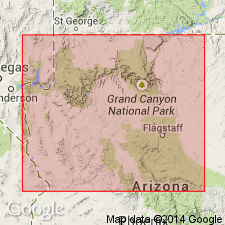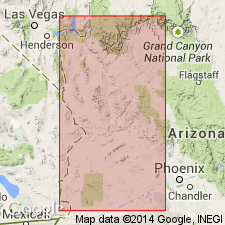
- Usage in publication:
-
- Milkweed Member
- Modifications:
-
- Named
- Dominant lithology:
-
- Conglomerate
- AAPG geologic province:
-
- Plateau sedimentary province
Summary:
Shown on diagrammatic cross sections of Milkweed Canyon and Peach Springs Canyon as lower member of Buck and Doe Conglomerate, Hualapai Plateau, northwest AZ. Overlies Westwater Formation (new) and Hindu Fanglomerate (new). Underlies Peach Springs Member (new) (Buck and Doe Conglomerate) in Peach Springs Canyon. Underlies Peach Springs Tuff in Milkweed Canyon. Is Cenozoic age. [may be one of units described as Milkweed Canyon gravels by Gray (1964)]
Source: GNU records (USGS DDS-6; Menlo GNULEX).

- Usage in publication:
-
- Milkweed Member
- Modifications:
-
- Areal extent
- AAPG geologic province:
-
- Plateau sedimentary province
Summary:
Diagrammatic section of Cenozoic deposits on western part of Hualapai Plateau shows Milkweed Member of Buck and Doe Conglomerate as 0 to 150 ft of limestone conglomerate. Overlies Westwater Formation. Underlies Peach Springs Member of Buck and Doe Conglomerate.
Source: GNU records (USGS DDS-6; Menlo GNULEX).
For more information, please contact Nancy Stamm, Geologic Names Committee Secretary.
Asterisk (*) indicates published by U.S. Geological Survey authors.
"No current usage" (†) implies that a name has been abandoned or has fallen into disuse. Former usage and, if known, replacement name given in parentheses ( ).
Slash (/) indicates name conflicts with nomenclatural guidelines (CSN, 1933; ACSN, 1961, 1970; NACSN, 1983, 2005, 2021). May be explained within brackets ([ ]).

